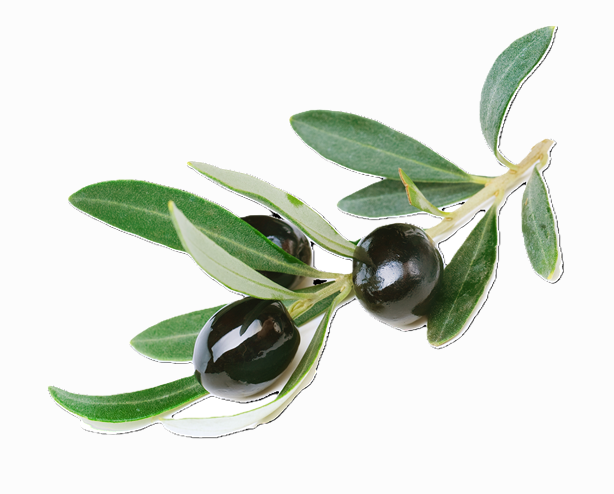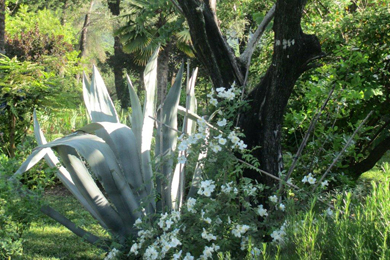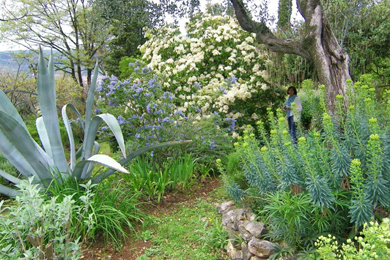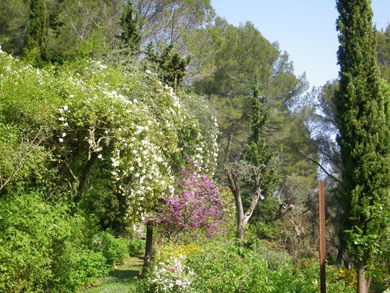Joanna’s Garden near Tourrettes-sur-Loup
General Description: When we first arrived at the Prieuré we found the garden uncared for but with many interesting trees and shrubs. About twenty original olive trees survive and they give good fruit for oil every two years. There is no particular style to the garden, it has grown ‘like Topsy’ over the years and its design, if you can call it that, has been governed by its ‘planches’ or terraces.
A previous owner had planted Iris unguicularis, now growing everywhere, as do cotoneasters, pittosporums and oleanders. There were umbrella pines, a fig tree, several roses and a large Cupressus macrocarpa. The first things we planted were a Wisteria chinensis to cover a pergola in front of the house and several Eucalyptus globulus.
Since we are on alkaline soil, other plants that do well include hellebores and euphorbias, particularly rigida, with its acid yellow spring flowers. In February Japanese quinces, Chaenomeles japonica, give a warm, rosy glow and Sarcococca hookeriana faithfully fills the garden with a wonderful scent. A large Garrya elliptica with its elegant catkins gives great pleasure in late winter. Peonea suffruticosa does well and some ceanothus thrive, particularly ‘Trewithin Blue’ and ‘Concha’. Bearded irises – we have many varieties – are show-stoppers.
Soil and climate: The soil is generally alkaline, over 7pH, but there are small pockets of neutral soil where acers have survived. We enrich the soil with home made compost, mulch and sheep manure called Migon..
The Mediterranean climate is supposed to have long hot summers and cool wet winters, but recently this has by no means been the case. In February 2012, snow fell and stayed for a week and frost devastated small plants and shrubs alike.
About 35 years ago we drilled down 40 metres to make a well and during the first 25 years we had plenty of water. However with encroaching building on the mountainside behind, drills have been made into our water vein and the debit is reduced. Therefore, as our water supply is now limited, we only water plants during their first and second years and the rest of the garden has to look after itself.
Plants and Projects: My gardening is haphazard; I call myself a plantswoman, rather than a gardener and I allow plants to seed themselves wherever possible. These are mainly indigenous species: hellebores, coronillas, Euphorbia rigida, acanthus and Spanish broom.
I love the grey leaved plants, santolinas, Stachys byzantina, centaureas and artemisias which contrast so well with the deep purple smoke bush Cotinus coggygria, and the acers. Other specialities are buddleias, chosen to attract butterflies, including davidii, weyeriana, crispa and lindleyiana.
Then there is the golden rain tree, Koelreuteria, catalpas, the December-flowering, sweet-smelling Chimonathus praecox and for summer scent, delicious Cestrum nocturnum. My latest joy is a long flowerbed of Lavandula angustifolia ‘Hidcote’ to encourage butterflies and bees.
Roses are of great interest here – one in particular originates from La Mortola in Italy, and can be purchased from frenchtearose.com under my name, Joanna Millar. In my garden this rose romps away up a cypress tree – an astounding sight with its many thousands of yellow blossoms in March and April.
Many roses have come from England: ‘Constance Spry’, ‘Seagull’, ‘Rambling Rector’, ‘Cecile Brunner’ and ‘Bobby James’. Here when we arrived was Rosa ‘General Schablikine’, and R. banksiae ‘Lutea’. We don’t prune climbing roses, only cut out dead wood, and let them romp up cypress or olive trees. Other shrubs are trimmed but allowed as much freedom as possible to give a natural and luxuriant look to the garden.
Visits: I would be happy to receive visits from members at any time of the year. Appointments at Joanna Millar or by telephone at 04 93 24 18 77. We speak French and English.
![]()




